How OEM Parts Shape Automotive Manufacturing: The Backbone of Reliability

Behind every smooth ride, efficient engine, and high-performance vehicle lies the quiet work of Original Equipment Manufacturer (OEM) parts. These components, engineered to exact specifications by automotive brands or their partners, ensure vehicles perform reliably, meet safety standards, and maintain their longevity. But what does it take to design, manufacture, and integrate these parts at scale in a rapidly evolving industry?
This in-depth article explores the critical role OEM parts play in automotive manufacturing, the challenges manufacturers face, and how innovation is reshaping the future of this foundational industry.
OEM parts are designed and manufactured by or for the original vehicle maker, ensuring perfect compatibility and meeting stringent quality standards. Their distinguishing features include:
Precision Engineering: Each component is crafted to match the vehicle’s specifications exactly, ensuring seamless integration and optimal performance.
Quality Assurance: Rigorous testing processes guarantee durability, reliability, and safety.
Brand Consistency: OEM parts align with the automaker’s brand promise, maintaining the vehicle’s integrity and value.
Example: Toyota’s commitment to OEM parts is evident in its "Kaizen" philosophy, emphasizing continuous improvement and uncompromising quality.
The journey of an OEM part from design to deployment involves a highly coordinated supply chain. Key stages include:
Design and Prototyping: Engineers collaborate with automakers to develop parts that meet specific vehicle requirements.
Manufacturing: Precision machinery and advanced robotics ensure consistent quality across millions of parts.
Integration: Parts are delivered just-in-time to assembly lines, aligning with lean manufacturing practices.
Anecdote: During the production of the Ford F-150, the company worked closely with its Tier 1 supplier, Magna International, to integrate lightweight aluminum frames that reduced the truck’s weight without compromising strength.
Producing OEM parts at scale is not without its hurdles. Key challenges include:
a. Supply Chain Disruptions:
Global events, such as the COVID-19 pandemic, exposed vulnerabilities in supply chains, leading to delays in part deliveries.
b. Rising Material Costs:
Fluctuations in the price of raw materials like steel, aluminum, and semiconductors directly impact production costs.
c. Regulatory Compliance:
OEM parts must meet increasingly stringent environmental and safety standards across global markets.
Example: The 2021 semiconductor shortage forced automakers like General Motors to temporarily halt production lines, highlighting the dependency on a seamless parts supply chain.
The OEM parts sector is evolving rapidly, with innovations transforming design, production, and logistics:
a. Advanced Materials:
Lightweight composites, high-strength alloys, and recycled materials are replacing traditional metals to improve vehicle efficiency.
b. Additive Manufacturing (3D Printing):
OEM parts like brackets, housings, and even engine components are now being 3D printed, enabling rapid prototyping and on-demand production.
Case Study: BMW uses 3D printing for several OEM parts in its vehicles, reducing production time and material waste while maintaining high precision.
c. Predictive Analytics:
Data-driven insights optimize inventory management and predict part failures, ensuring uninterrupted supply chains.
Sustainability is becoming a priority for OEM parts manufacturers:
Green Manufacturing: Factories powered by renewable energy and employing energy-efficient processes.
Recycling and Reuse: Closing the loop by recycling parts and reintroducing materials into the production cycle.
Eco-Friendly Packaging: Reducing waste through reusable and biodegradable packaging solutions.
Insight: Volkswagen’s commitment to sustainability includes using recycled aluminum for engine blocks, reducing energy consumption by 95% compared to new aluminum production.
Close partnerships between OEM parts manufacturers and automakers are crucial to success:
Joint R&D Efforts: Collaborating on new technologies, such as electric and autonomous vehicle components.
Customization: Developing unique parts tailored to a specific vehicle model or feature.
Integrated Logistics: Leveraging digital supply chains for real-time tracking and efficient part deliveries.
Anecdote: Tesla’s partnership with Panasonic for battery production exemplifies the power of collaboration, driving innovation and ensuring supply chain reliability.
The rise of EVs and AVs is reshaping the OEM parts landscape:
Electric Powertrains: New components, such as battery packs and electric motors, require specialized OEM manufacturing capabilities.
Autonomous Sensors: LIDAR, radar, and camera systems add layers of complexity to OEM production.
Software-Defined Vehicles: As vehicles become increasingly software-driven, OEMs must integrate hardware with advanced software solutions.
Example: Bosch, a leading Tier 1 supplier, is investing heavily in producing sensors and control units for autonomous and electric vehicles.
AiDOOS provides tailored solutions to help OEM parts manufacturers thrive in this dynamic industry:
Access to Expert Talent: On-demand teams for material innovation, robotics integration, and supply chain optimization.
SaaS Tools: Streamlined inventory management, predictive analytics, and quality control.
Agile Scaling: Scale operations to meet demand spikes or adapt to new technologies quickly.
OEM parts are the unsung heroes that make modern vehicles reliable, safe, and efficient. As the automotive industry evolves, these components will remain central to innovation and sustainability. With the support of platforms like AiDOOS, OEM parts manufacturers can navigate challenges, embrace opportunities, and continue shaping the future of mobility.
Original Equipment Manufacturer (OEM) parts are the cornerstone of automotive manufacturing, ensuring the durability, safety, and performance of vehicles. However, managing the complexities of OEM supply chains in a fast-paced industry requires advanced solutions. Virtual Delivery Centers (VDCs) offer a transformative approach to streamline and enhance the manufacturing process.
How VDCs Elevate OEM Parts Production and Supply Chains:
Optimized Supplier Collaboration:
Connect global suppliers, manufacturers, and logistics teams on a unified digital platform.
Enable real-time tracking and communication to ensure timely delivery of critical components.
Precision Manufacturing Through Digital Twins:
Utilize VDCs to simulate production environments using digital twin technology.
Predict and resolve potential manufacturing issues before they impact production.
Accelerated R&D Cycles:
Leverage global expertise through VDCs for rapid prototyping and testing of new OEM parts.
Foster innovation by integrating AI-driven insights into design and material selection.
Seamless Quality Assurance:
Implement AI-powered monitoring systems to uphold stringent quality standards at every production stage.
Reduce defects and enhance compliance with industry regulations.
Enhanced Inventory Management:
Employ predictive analytics to optimize inventory levels and reduce waste.
Streamline just-in-time delivery systems to lower storage costs and prevent overstocking.
Sustainability in OEM Manufacturing:
Incorporate circular economy practices to recycle and reuse materials in the production cycle.
Monitor and minimize carbon footprints across the supply chain.
Why VDCs Are Indispensable for OEM Parts Success:
Scalability: Adapt to increasing production demands without compromising quality.
Cost-Effectiveness: Reduce overheads through automation and centralized operations.
Agility: Quickly respond to market changes and unforeseen disruptions.
Conclusion:
Virtual Delivery Centers empower OEM parts manufacturers to maintain their role as the backbone of the automotive industry. By adopting VDCs, companies can enhance reliability, foster innovation, and ensure seamless operations, ultimately delivering superior vehicles to the market.

By redesigning packaging, exploring reusable models, investing in smart tracking, and leveraging the VDC model for execution, beverage manufacturers can reduce their environmental footprint while boosting their brand relevance and operational resilience.

Even the most capable in-house IT teams often fall short when it comes to minimizing downtime. While Managed Services solve much of the downtime problem, the VDC model supercharges it with flexibility, scalability, and domain-specific expertise.